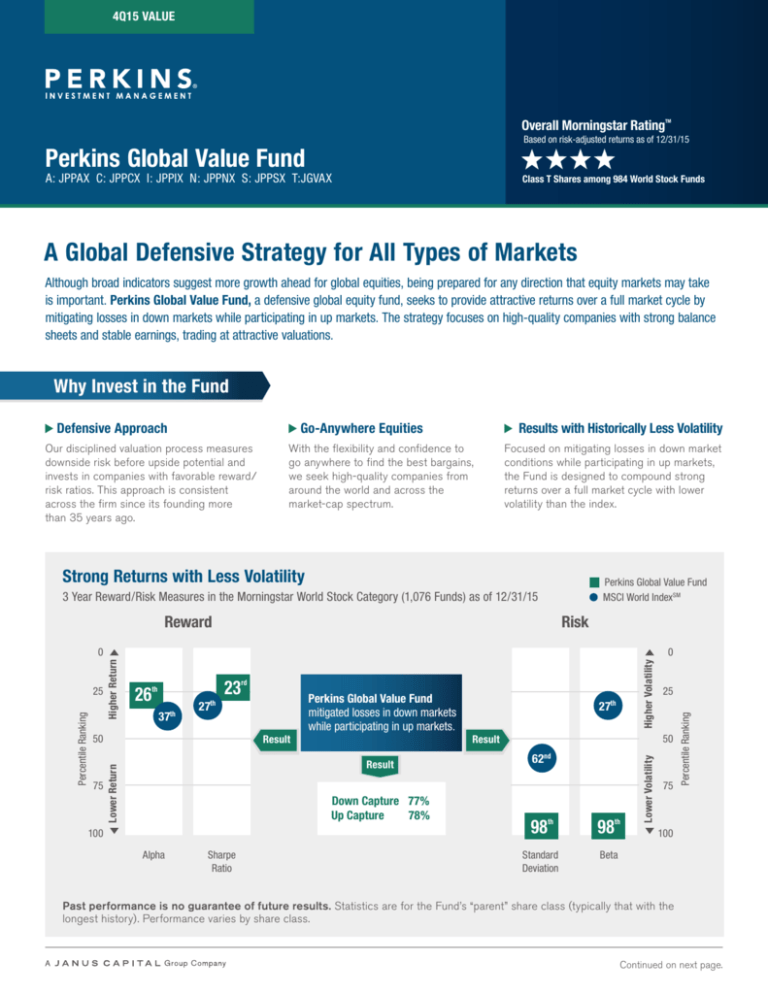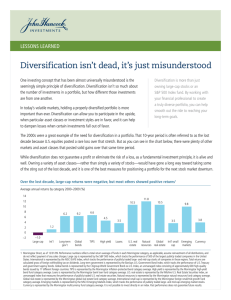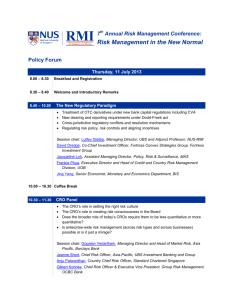
4Q15 VALUE
Overall Morningstar Rating
TM
Based on risk-adjusted returns as of 12/31/15
Perkins Global Value Fund
A: JPPAX C: JPPCX I: JPPIX N: JPPNX S: JPPSX T:JGVAX
Class T Shares among 984 World Stock Funds
A Global Defensive Strategy for All Types of Markets
Although broad indicators suggest more growth ahead for global equities, being prepared for any direction that equity markets may take
is important. Perkins Global Value Fund, a defensive global equity fund, seeks to provide attractive returns over a full market cycle by
mitigating losses in down markets while participating in up markets. The strategy focuses on high-quality companies with strong balance
sheets and stable earnings, trading at attractive valuations.
Why Invest in the Fund
Defensive Approach
Go-Anywhere Equities
Our disciplined valuation process measures
downside risk before upside potential and
invests in companies with favorable reward/
risk ratios. This approach is consistent
across the firm since its founding more
than 35 years ago.
Results with Historically Less Volatility
With the flexibility and confidence to
go anywhere to find the best bargains,
we seek high-quality companies from
around the world and across the
market-cap spectrum.
Focused on mitigating losses in down market
conditions while participating in up markets,
the Fund is designed to compound strong
returns over a full market cycle with lower
volatility than the index.
Strong Returns with Less Volatility
Perkins Global Value Fund
MSCI World IndexSM
3 Year Reward/Risk Measures in the Morningstar World Stock Category (1,076 Funds) as of 12/31/15
Reward
Risk
27th
Result
50
75
rd
Perkins Global Value Fund
mitigated losses in down markets
while participating in up markets.
Result
Down Capture 77%
Up Capture
78%
100
Alpha
Sharpe
Ratio
27th
Result
25
50
62
nd
98
th
Standard
Deviation
98
th
75
Percentile Ranking
37th
Higher Volatility
23
th
Lower Volatility
26
Lower Return
Percentile Ranking
25
0
Higher Return
0
100
Beta
Past performance is no guarantee of future results. Statistics are for the Fund’s “parent” share class (typically that with the
longest history). Performance varies by share class.
Continued on next page.
Perkins Global Value Fund (as of 12/31/15)
Gregory Kolb, CFA
Portfolio Manager
Fund Manager since 2005
Industry since 1998
Tadd H. Chessen, CFA
Portfolio Manager
Fund Manager since 2013
Industry since 1994
Perkins: Active Investing Since 1980
Fund Performance (%)
Class A Shares @ NAV
Class A Shares @ MOP
Class I Shares
Class T Shares
MSCI World IndexSM
MSCI All Country World IndexSM
1 yr
3 yr
5 yr
10 yr
Since Inception
(6/29/01)
-2.20
-7.79
-1.98
-2.08
-0.87
-2.36
7.61
5.52
7.89
7.69
9.63
7.69
7.13
5.87
7.44
7.25
7.59
6.09
4.76
4.14
4.90
4.90
4.98
4.75
6.09
5.66
6.28
6.28
4.98
5.07
Returns quoted are past performance and do not guarantee future results; current performance
may be lower or higher. Investment returns and principal value will vary; there may be a gain or loss
when shares are sold. For the most recent month-end performance call 877.33JANUS (52687) or
visit janus.com/advisor/mutual-funds.
Maximum Offering Price (MOP) returns include the maximum sales charge of 5.75%. Net Asset
Value (NAV) returns exclude this charge, which would have reduced returns.
Expense Ratios (%)
Class A
Class I
Class T
This Fund’s Active Share – 88%
Gross
1.09
0.81
1.01
Active Share is a measure of the percentage
of holdings in a portfolio that differ from its
benchmark index.
Net
1.09
0.81
1.01
Morningstar Rankings:
Class T Shares
Percentile Ranking (%)
World Stock Category Rank/Count
1 yr
3 yr
5 yr
Since Inception
(6/29/01)
10 yr
58
63
41
56
34
729/1,255
676/1,076
336/893
339/609
151/446
For more information, please contact your Financial Advisor or visit janus.com.
Please consider the charges, risks, expenses and investment objectives carefully before investing. For a prospectus or, if available,
a summary prospectus containing this and other information, please call Janus at 877.33JANUS (52687) or download the file from
janus.com/info. Read it carefully before you invest or send money.
Performance for Class A Shares and Class I Shares prior to 7/6/09 reflects the performance of one or more similar share classes of the Fund or a predecessor fund,
adjusted, where applicable and permitted, for differing fees and expenses. See the Fund’s prospectus for further details concerning historical performance.
Returns include reinvestment of dividends and capital gains. Returns greater than one year are annualized.
This Fund has a performance-based management fee that may adjust up or down based on the Fund’s performance.
There is no assurance that the investment process will consistently lead to successful investing. There is no assurance the stated objective(s) will be met.
When valuations fall and market and economic conditions change it is possible for both actively and passively managed investments to lose value.
Mutual fund investing involves market risk. Investment return and fund share value will fluctuate and it is possible to lose money by investing.
Foreign securities are subject to additional risks including currency fluctuations, political and economic uncertainty, increased volatility, lower liquidity and differing
financial and information reporting standards, all of which are magnified in emerging markets.
The Perkins Global Value Fund was rated against the following numbers of U.S.-domiciled World Stock funds over the following time periods: 984 funds in the last
three years and for the Overall rating, 781 funds in the last five years, and 417 funds in the last ten years. With respect to these World Stock funds, Perkins Global
Value Fund received a Morningstar RatingTM of 3 stars, 4 stars and 4 stars for the three-, five- and ten-year periods, respectively.
The Overall Morningstar RatingTM for a fund is derived from a weighted average of the performance figures associated with its three-, five- and ten-year (if applicable)
Morningstar RatingTM metrics. For each fund with at least a three-year history, Morningstar calculates a Morningstar RatingTM based on a Morningstar Risk-Adjusted
Return measure that accounts for variation in a fund’s monthly performance (including the effects of sales charges, loads, and redemption fees), placing more emphasis on downward variations and rewarding consistent performance. The top 10% of the funds in each category receive 5 stars, the next 22.5% receive 4 stars, the
next 35% receive 3 stars, the next 22.5% receive 2 stars and the bottom 10% receive 1 star. (Each share class is counted as a fraction of one fund within this scale
and rated separately, which may cause slight variations in the distribution percentages.) The Morningstar RatingTM may differ among share classes of a mutual fund as
a result of different sales loads and/or expense structures. It may be based, in part, on the performance of a predecessor fund.
The Morningstar percentile ranking is based on the fund’s total-return percentile rank relative to all funds that have the same category for the same time period.
The highest (or most favorable) percentile rank is 1%, and the lowest (or least favorable) percentile rank is 100%. Morningstar total-return includes both income and
capital gains or losses and is not adjusted for sales charges. The top-performing funds in a category will always receive a rank of 1.
© 2015 Morningstar, Inc. All Rights Reserved.
Up/down capture shows what percentage of the market’s performance (as evidenced by an appropriate market index) the manager “captured.” Up market
capture is the extent to which the strategy gained value relative to the index over months when the index achieved gains. Down market capture is the extent to which
the strategy lost value over months when the index declined. A measure of 100% means the strategy results went up (or down) exactly the same amount as the
broader market index. Beta is a measure of the volatility of a portfolio in comparison to a benchmark index. Less than one means the portfolio is less volatile than
the index, while greater than one indicates more volatility than the index. Standard deviation measures historical volatility. Higher standard deviation implies greater
volatility. Sharpe Ratio measures risk-adjusted performance by dividing the portfolio’s excess returns (returns above a “risk-free” rate such as a Treasury bill) by the
standard deviation of those returns. The higher the ratio, the better the portfolio’s return per unit of risk. Alpha compares the risk-adjusted performance of a portfolio
to a benchmark index. A positive alpha means the portfolio has outperformed the index on a risk-adjusted basis.
MSCI World IndexSM is a market capitalization weighted index composed of companies representative of the market structure of Developed Market countries in
North America, Europe and the Asia/Pacific Region. The index includes reinvestment of dividends, net of foreign withholding taxes. MSCI All Country World IndexSM is
an unmanaged, free float-adjusted market capitalization weighted index composed of stocks of companies located in countries throughout the world. It is designed
to measure equity market performance in global developed and emerging markets. The index includes reinvestment of dividends, net of foreign withholding taxes.
A Fund’s portfolio may differ significantly from the securities held in an index. An index is unmanaged and not available for direct investment; therefore its performance
does not reflect the expenses associated with the active management of an actual portfolio.
Not all Funds and Share classes may be available. Please consult your financial advisor.
Perkins Investment Management LLC is a subsidiary of Janus Capital Group Inc. and serves as the sub-adviser on certain products.
Janus and Perkins are registered trademarks of Janus International Holding LLC. © Janus International Holding LLC.
Janus Distributors LLC
C-1215-107056 04-15-16
197-15-28386 01-16











